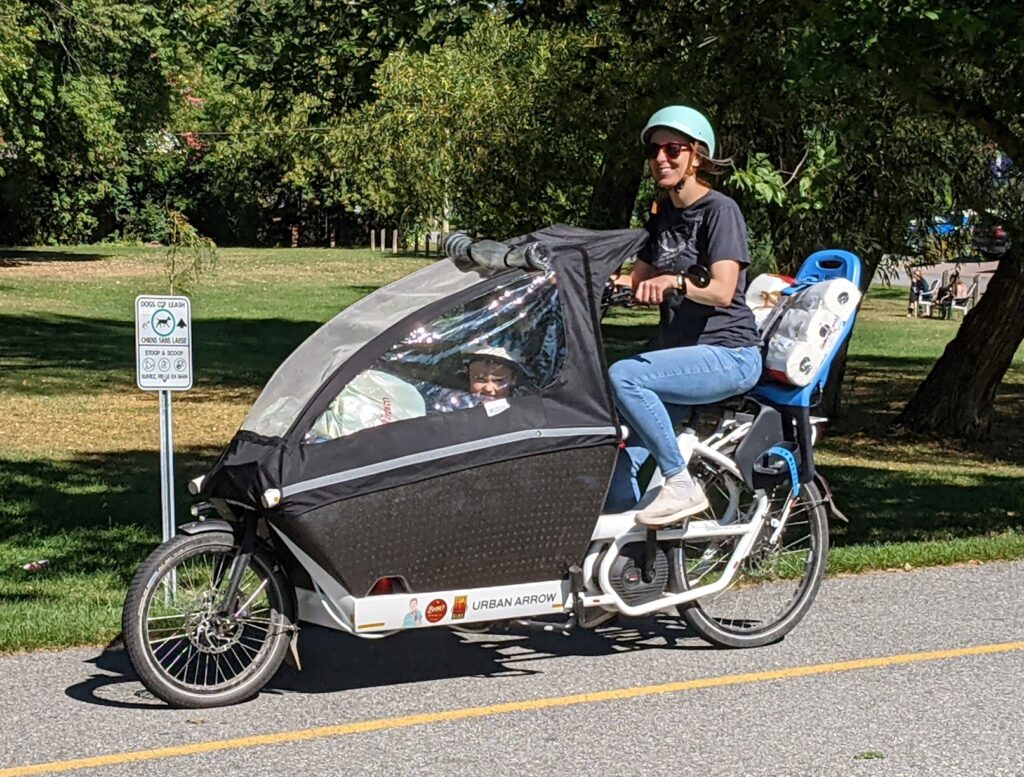In its new Official Plan, the City of Ottawa states its desire to work toward building “15-minute neighbourhoods” as part of its efforts to build a better and more sustainable city.
Guest post by Cassie Smith.
In a city with 15-minute neighbourhoods you would be able to access the things you need in daily life – groceries, swimming lessons, a pharmacy, and more – within a 15-minute walk of your home. As a parent of two young kids, I saw this as a desirable direction for the city to aim for, but it also raised some questions and led me to Carleton University to study the idea as part of my master’s degree.
I wanted to know how residents responded to the ways the city was making it easier for residents to walk or bike to nearby destinations. If the city built a new walking or cycling path or an active transportation footbridge, would people begin walking or biking for these trips?
According to my research, the short answer is no*.
One of the key reasons is that while many of the destinations valued in Ottawa’s 15-minute neighbourhood plan are central to the lives of children and caregivers (parks, schools, child care facilities, and indoor recreational and community facilities, including libraries), the distance children can travel in a 15-minute walk is much shorter from the 1200m distance an average person can cover. In the interviews I conducted parents told me about the ‘time squeeze’ they faced if they were to walk for trips to school, groceries, childcare, and more. This was even the case for parents whose children were grown and moved out of their house (even those who were now grandparents). These challenges left an enduring mark.
Another reason residents identified when they would drive instead of walking or biking was to do a big grocery shop, pick up large items from a retail store, or for sports and activities with large equipment. Again, people with caregiving responsibilities felt this acutely as their families grew along with the size of their grocery shopping trips.
Both of these challenges, travelling with children and transporting cargo, could be mitigated with the use of e-cargo bikes. But right now, e-cargo bikes are few and far between in Ottawa (although maybe that is changing, as we saw at last fall’s Kidical Mass ride). This means residents might not know about these bikes as an option and may be intimidated by the up-front costs or commitment required. For some, there may be challenges with secure parking or a lack of (year-round) safe infrastructure in some parts of the city.

In my thesis, I suggest that the city explore incentives and programs to enable more people to be able to desire, acquire and use sustainable cargo-carrying devices like (e-) cargo-bikes, shopping carts, strollers/wagons, and shared mobility. Additionally, a year-round public bike share that includes cargo bikes could be especially beneficial for helping residents explore these mobility devices. It will also be important that there are adequate, safe, and well-maintained spaces to travel and appropriate and secure parking spaces at homes and destinations.
Championing cargo bikes as a sustainable solution is a key reason I joined the board of Bike Ottawa. If you have any cargo bike questions or stories feel free to reach out to me. And stay tuned for news about 2024 Kidical Mass and cargo bike ride events.
*You can read more about the much longer and more detailed answer in my thesis. See more here.
Cassie Smith is a Bike Ottawa board member.

